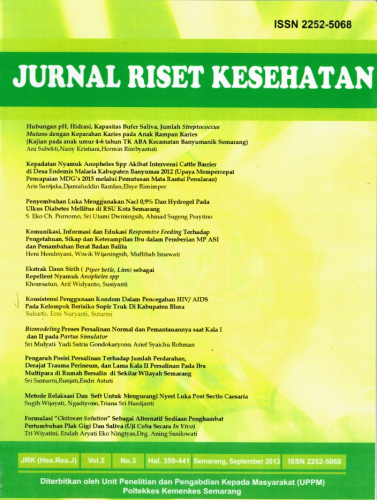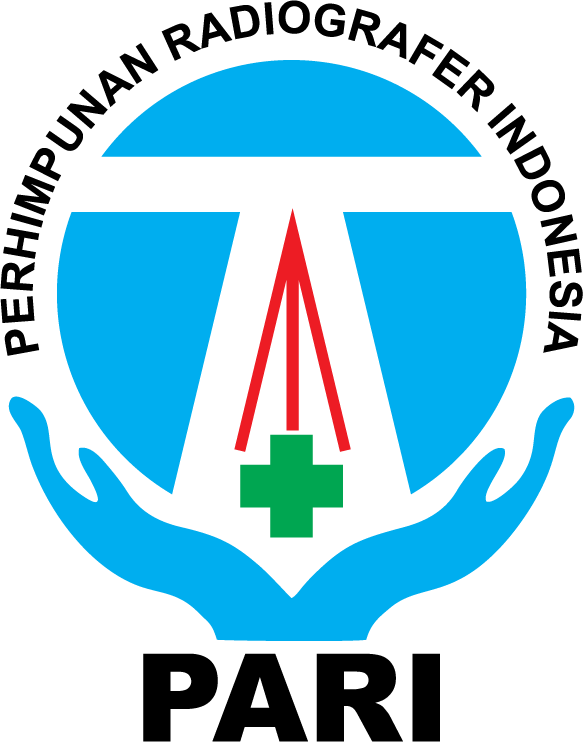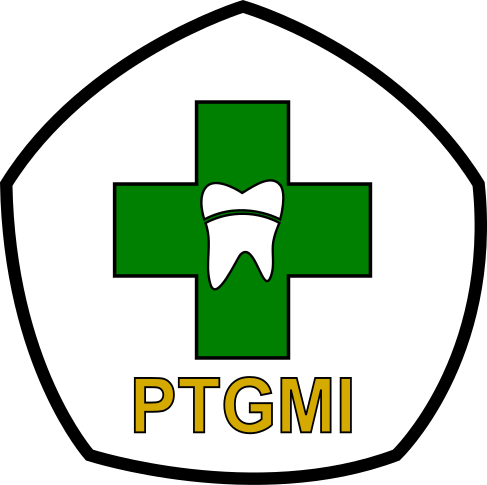THE SURVEY OF SAFETY CULTURE IN RSUP Dr.KARIADI SEMARANG
Abstract
Patient safety in hospitals is a crucial issue as significant medication errors occur in some countries. Patient safety incidence is inevitably related to safety culture implemented in hospitals. This survey aims to investigate the dimension of patient safety serving as a strong area and dimension for potential improvement. This study used a cross-sectional approach involving 361 subjects in all units in RSUP Dr. Kariadi. Findings are presented in graphs and frequency tables. This study found three dimensions of strength area involving management support regarding patient safety (92.93%), organizational learning-continuous improvement (91.73%), and unit cooperation (86.1%). Meanwhile, the area for potential improvement involving employment (45.43%), incidence report frequency (58.07%), and open communication (60.67%). Dimensions serving as strength areas need to be maintained while dimension for potential improvement need for support to cultivate patient safety culture in RSUP Dr. Kariadi.
Keywords
Full Text:
PDFReferences
Agency for Health Care Research and Quality. (2004). Hospital Survey on Patient Survey Culture. Agency for Health Care Research and Quality, 1-5.
Alharbi, W., Cleland, J., and Morrison, Z. (2018). Assessment of Patient Safety Culture in an Adult Oncology Department in Saudi Arabia. Oman Medical Journal, 33(3), 200-208.
Alimohammadzadeh, K., Joladi, S.E., Olya, M., Ghaiyoomi, A., and Arani, H.Z. (2017). A Comparative Study on Effective Factors in Patient Safety Culture from the Nursing Staff Points of View. J. Health Man and Info., 4(2), 57-61.
Ali, P. A., and Panther, W. (2008). Professional Development and the Role of Mentorship. Journal of NursingStandard, 22(42), 35-39.
Alwabel, A.M., Bawazir, A.A., and Al-Surimi, K. (2015). Assessment of Patient Safety Culture Among Pharmacists in Riyadh Hospitals Saudi Arabia. Journal of Infection and Public Health, 8(4), 402.
Brborović, H., dan Brborović, O. (2017). Patient Safety Culture Shapes Presenteeism and Absenteeism: A Cross-Sectional Study among Croatian Healthcare Workers. Arh Hig Rada Toksikol, 68,185-189.
Budihardjo, A. (2008). The importance of Safety Culture in Hospitals: An attempt to minimize Adverse Events. Integritas-Jurnal Manajemen Bisnis, 1(1), 53-70.
Cahyono, J.B., and Suhardjo, B. (2012). Building Patient Safety Culture in Medical Practice. Yogyakarta: Kanisius.
Chen, I-Chi and Li, Hung-Hui. (2010). Measuring Patient Safety Culture in Taiwan Using the Hospital Survey on Patient Safety Culture (HSOPSC). BMC Health Service Research, 10,152.
Duffy, W. (2017). Improving Patient Safety by Practicing in a Just Culture. AORN Journal, 106(1), 66-68.
Galvao, T.F., Lopes, M.C.C., Olivia, C.C.C., Araujo, M.E.A., and Silva, M.T. (2018). Patient Safety Culture in a University Hospital. RLAE, 26, e3014.
Hirose, M., Egami, K., Tsudaya, Y., Honda, J., and Shima, H. A. (2013). Nationwide Survey on Patient Safety Culture in Japan. Value in Health, 16, A680.
IAEA. (1991). Safety culture. Safety Report 75-INSAG-4.
Iskandar, H., Maksum, H., and Nafsiah. (2014). Causing Factors of Decreased Patient Safety Incidence Report in Hospitals. Jurnal Kedokteran Brawijaya, (28(1), 72-77.
Jia, P., Zhang, L., Mao, X., and Zhang, M. (2014). Fostering Patient Safety Culture in Hospital to Improve Health Service: Hospital Survey on Patient Safety Culture. Value in Health, 17, A796.
Health Ministry of Republic of Indonesia. (2008). National Guidelines for Patient Safety in Hospitals. Jakarta.
Health Ministry of Republic of Indonesia. (2010). Strategic Plan of Health Ministry 2010-2014. Jakarta.
Health Ministry of Republic of Indonesia. (2011). Hospital Accreditation Standard, Cooperation between Directorate General of Health Care Promotion of Health Ministry of Republic of Indonesia and the Commission of Hospital Accreditation(KARS). Jakarta.
Hospital Safety committee (KKP-RS) PERSI. (2008). Guidelines of Patient Safety Incidence Report (IKP). Jakarta.
Hospital Safety committee (KKP-RS) PERSI. (2012). Guidelines of Patient Safety Incidence Report. Jakarta.
Lumenta A. (2008). Guidelines of Patient Safety Incidence Report: Patient Safety Incident Report. Jakarta: Hospital Patient Safety CommitteeKKP-RS.
Nurmalia, D., Handiyani, H., and Pujasari, H. (2013). The Effect of Mentoring Program towards the Implementation of Patient Safety Culture. Jurnal Manajemen Keperawatan, 1(2), 79-88.
Okuyama, J.H.H., Galvao, T.F., and Silva, M.T. (2018). Healthcare Professional’s Perception of Patient Safety Measured by the Hospital Survey on Patient Safety Culture: A Systematic Review and Meta-Analysis. The Scientific World Journal, 1, 1-11.
Pujilestari, A., Maidin, A., and Anggraeni, R. (2014).Patient Safety CultureiIn Inpatient Installation of RSUP Dr. Wahidin Sudirohusodo. Jurnal MKMI, 57-64.
Robbins, S., and Timoty, J. (2015). Organizational Behavior. Jakarta: Salemba Empat.
Sammer, E. C., Lykens, K., Singh, K.P., Mains, D.A., and Lackan, N.A. (2009). What is Patient Safety Culture? A Review Literature. Journal NursingScholarship, 42(2), 156.
Ultaria, T.D., Arso, S.P., and Sriatmi, A. (2017). Description of Patient Safety Culture in Roemani Muhammaddiyah Hospital Semarang. Jurnal Kesehatan Masyarakat, 5(1), 118-125.
Act No. 3 Regulating Workforces. (2003). Jakarta.
Vellyana, D., and Rahmawati, A. (2016). Blaming Culture and Mistake Publishment in Patient Safety Culture. Jurnal Ilmiah Kesehatan, 5(9), 600-613.
Wagner, V.D. (2014). Patient Safety : A Cultural Affair. AORN Journal, 100(4), 355-357.
Wei, E., Bassin, B., Santen, S., Sharp, B., Hopson, L., Somand, D., and Fischer, J. (2015). Patient Safety Culture in the Emergency Department. Annals of Emergency Medicine, 66(4s), S51-S52.
World Health Organization. (2018). Patient Safety, About Us. http://www.who.int/patient safety/about/en/index.html [accessed 30th April 2018].
DOI: https://doi.org/10.31983/jrk.v8i2.3811
Article Metrics
Refbacks
- There are currently no refbacks.
Copyright (c) 2019 Elyana Sri Sulistyowati, Septi Dewi Muninggar, Verarica Silalahi, Debi Ariyanto, Endang Fatmawati, Dharma Wahyu Edhy, Anggit Anandoyo




















































